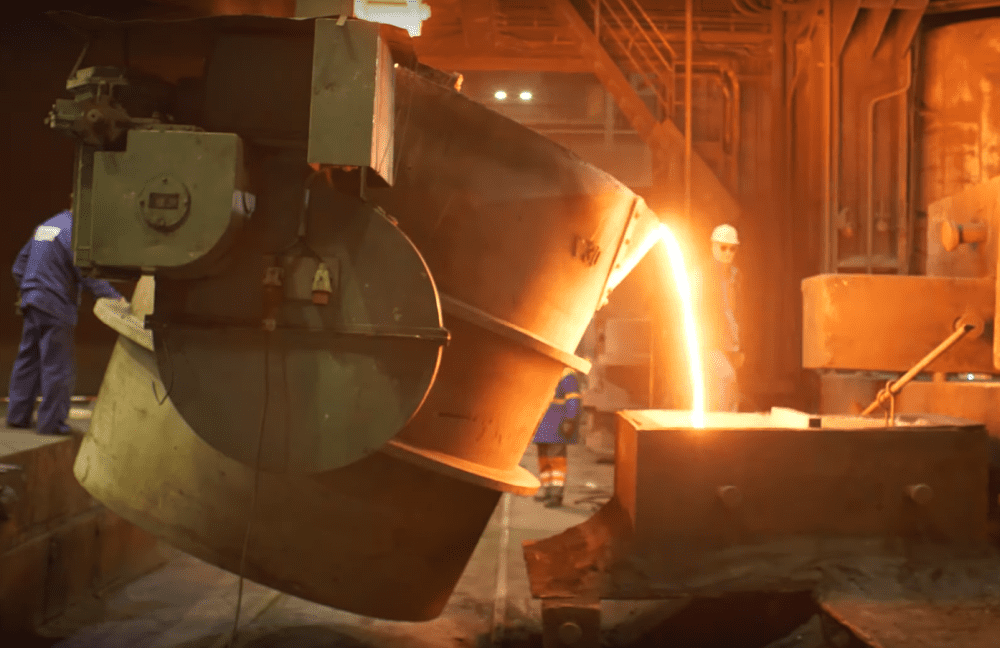
[Image above] Screenshot from a Pilsen Steel foundry video showing the transport and pouring of molten metal. Credit: Pilsen Steel, YouTube
Even though September just started, I’m already feeling the crisp bite of autumn weather each morning in Ohio. Fortunately, the upcoming online course by the Edward Orton Jr. Ceramic Foundation on refractory fundamentals provides the perfect way to heat up your learning even as the cold settles in.
Refractories are a special subset of ceramics designed to withstand the very high temperatures encountered in modern manufacturing. They are used to line the hot surfaces found inside many industrial processes.
Among the various classes of refractories, alumina spinel castables are well known for their role in the steel industry. These castables line the sidewalls and bottom of the steel ladle, a huge metal container used for holding and transporting liquid steel.
There are two types of alumina spinel castables used in the ladle.
- Alumina magnesia castables are used in the ladle sidewall, and they form in-situ spinel. (I.e., the magnesia reacts with the alumina in the castable matrix at high temperatures to form spinel.)
- Spinel-containing alumina castables are used in the bottom portion of the ladle, and they contain preformed spinel. (I.e., spinel is added directly as an aggregate in the castable composition.)
The alumina magnesia “spinel-forming” castables have a low hot strength and consequently low erosion resistance. However, ladle sidewalls are less subject to erosion compared to the bottom, and the spinel-forming castables offer stress relaxation (elastic behavior), which helps the sidewalls avoid stress peaks and cracking.
In contrast to the sidewalls, the most important factors for steel ladle bottoms are volumetric stability under high temperature and pressure, as well as high erosion resistance. Thus, the spinel-containing alumina castables best serve this purpose.
The performance and properties of alumina spinel castables depend on multiple parameters, such as the composition, spinel/magnesia content, particle size of the constituents, binder types, and additives.
For those new to the refractory field, having an article that provides a rundown of these parameters and their known influence on properties would be quite valuable. Fortunately, a new review paper published in International Journal of Applied Ceramic Technology provides just such a handy resource.
Written by two researchers from the National Institute of Technology, Rourkela, in India, the 30-page (unformatted) paper provides a detailed breakdown on the alumina spinel castables used in steel ladles. Below are some key takeaways from the paper.
Effect of spinel content on alumina spinel castables
The spinel family is a mineral group of oxides with a face-centered cubic crystal structure. The general formula is AB2O4, where A is a divalent metal ion (e.g., magnesium, iron, nickel, manganese, zinc) and B is a trivalent metal ion (e.g., aluminum, iron, chromium, manganese).
In the case of steel ladles, magnesium aluminate spinel is used due to its unique combination of properties, including high melting point, higher strength at elevated temperatures, high thermal shock resistance, excellent corrosion resistance, and low thermal expansion coefficient.
Optimal spinel content for spinel-containing and spinel-forming castables ranges between 15–30 wt.%, preferably 20–25 wt.%. A smaller amount of spinel leads to a higher corrosion rate, while a higher amount of spinel leads to a higher penetration rate because the spinel does not react with the infiltrated slag.
Effect of additives on alumina spinel castables
Various groups have studied the effects of different additives and mineralizers on the processing and properties of alumina spinel castables.
Titanium dioxide is one of the most effective mineralizers for accelerating the reactions for the in-situ spinel. It also can enhance the strength and volume stability in the alumina-magnesia castable system.
Rare earth oxides improve the castable’s sintering properties. Some authors also suggest that addition of CeCl3 and YCl3 will enhance spinel and calcium hexa aluminate formations in spinel-forming castables.
Micro silica is an essential ingredient in any cement-containing castable system as it acts as a flow modifier for the castable. However, silica may affect the quality of steel and reduce the thermomechanical properties of the castable. So, addition of silica should be kept below 1 wt.%.
Future possibilities for nanotechnology in alumina spinel castables
In a section discussing possible future work on alumina spinel castables, the authors note the potential for using nanotechnology to improve the castables.
“The main challenges associated with implementing nanotechnology are mixing techniques, uniform distribution of nanoparticles, avoidance of agglomeration, etc.,” they write.
The paper, published in International Journal of Applied Ceramic Technology, is “Alumina spinel castable for steel ladles: An overview” (DOI: 10.1111/ijac.14213).
